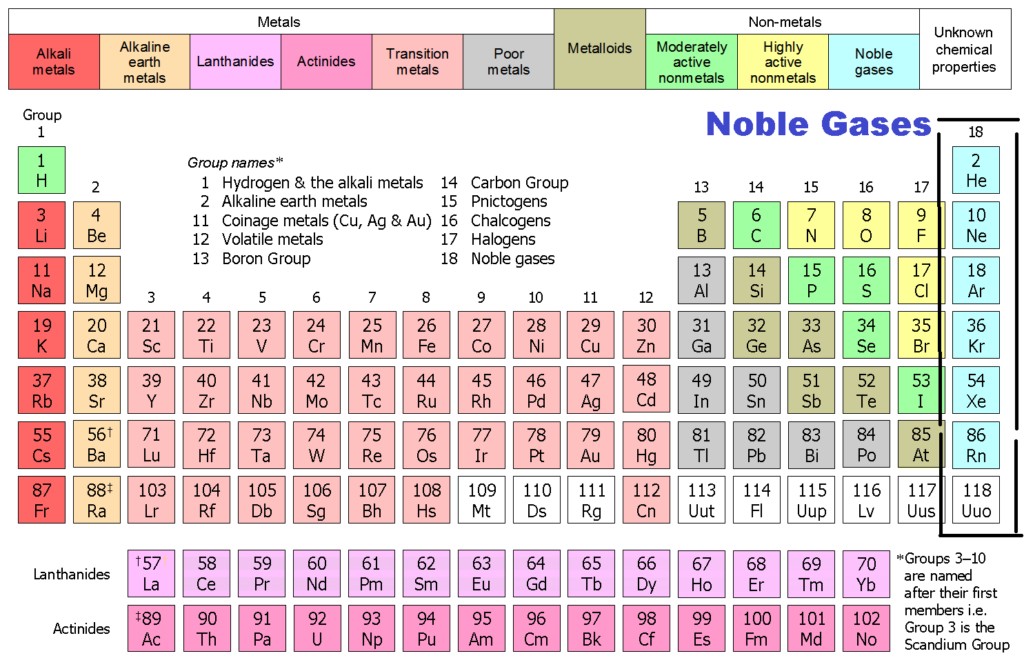Unveiling the Mystery: Xenon, the Noble Gas Beyond Krypton
The periodic table holds a treasure trove of elements, each with unique properties and characteristics. Following the well-known Krypton (Kr) on the noble gas group sits Xenon (Xe), an element shrouded in a veil of intrigue. This comprehensive guide delves into the fascinating world of Xenon, exploring its discovery, properties, applications, and its position within the noble gas family.
A Glowing Discovery: Unveiling Xenon
Xenon’s story begins in 1898 with Scottish chemist William Ramsay and his collaborator, Morris Travers. While investigating the residue left behind after liquefying and evaporating liquid air, they stumbled upon a new element heavier than Argon (Ar) and exhibiting a peculiar glowing quality in a discharge tube. Ramsay, inspired by the Greek word “ξένος” (xenos) meaning “stranger” or “foreigner,” christened the new element Xenon.
Xenon’s Place in the Periodic Table
Xenon belongs to Group 18 (or 18 according to the older numbering system) of the periodic table, also known as the noble gases. These elements share a distinctive characteristic: their outermost electron shell is completely filled, making them highly stable and unreactive. This inert nature is why they were historically referred to as “noble” or “rare” gases (although some are not particularly rare). Xenon resides beneath Krypton (Kr) and above Radon (Rn) within this group.
Properties of the Elusive Xenon
Xenon is a colorless, odorless, and tasteless noble gas at standard temperature and pressure. However, it possesses some intriguing properties:
- High Density: Xenon is one of the densest gases, about four times denser than air. This property makes it suitable for certain specialized applications.
- Luminescence: Xenon glows with a distinctive blue color when subjected to an electric current. This characteristic has led to its use in various lighting applications.
- Anesthetic Properties: At high concentrations, Xenon can act as an anesthetic, offering unique advantages in certain medical procedures.
- Solvent Potential: Surprisingly, Xenon exhibits some solvent properties. Under specific conditions, it can dissolve certain organic compounds, making it useful in some scientific research.
Unveiling the Applications of Xenon
Xenon’s unique properties have led to a variety of applications:
- Flashlamps: Xenon’s luminescent properties make it ideal for strobe lights and high-speed photography flash units.
- Anesthesia: Xenon can be used as an inhalation anesthetic, offering benefits like rapid induction and emergence from anesthesia, minimal cardiovascular depression, and a low risk of nausea and vomiting. However, its high cost limits its widespread use in this domain.
- Rocket Propulsion: Xenon’s high density makes it a suitable propellant for ion thrusters in spacecraft. These thrusters offer very high efficiency for long-duration space missions.
- Food Packaging: The inert nature of Xenon can be used to prevent food spoilage by displacing oxygen, which can promote oxidation and bacterial growth.
- Medical Imaging: Xenon isotopes are used in some specialized medical imaging techniques, such as single-photon emission computed tomography (SPECT).
FAQ
- Is Xenon safe to breathe?
Xenon is not typically harmful in small quantities. However, breathing high concentrations of Xenon can cause anesthesia and potentially lead to respiratory depression or even death if not administered in a controlled medical setting.
- Is Xenon radioactive?
Xenon has several isotopes, most of which are stable. However, one isotope, Xenon-135, is radioactive with a half-life of about 9.1 hours. This isotope is not commonly encountered and doesn’t pose a significant radiation threat.
- Where is Xenon found in nature?
Xenon is a trace element in Earth’s atmosphere, making up about one part per million. Small quantities are also found in certain minerals and natural gas deposits.
- What are the future prospects for Xenon?
The unique properties of Xenon continue to be explored for potential applications. Areas of ongoing research include its use in next-generation lighting technologies, improved methods for food preservation, and advancements in medical imaging and anesthesia.
- How does Xenon compare to other noble gases?
While all noble gases share similar unreactive properties, Xenon stands out for its high density, anesthetic properties, and surprising ability to act as a solvent under specific conditions. These unique characteristics distinguish Xenon from other noble gases like Helium (He) or Neon (Ne).
Conclusion: Xenon – Beyond Inert
Xenon, the element following Krypton on the periodic table, transcends its classification as a noble gas. Its unique properties have opened doors to fascinating applications in diverse fields, from illuminating our world with strobe lights to propelling spacecraft on long journeys through the cosmos. As research continues to unveil the potential of Xenon, we can expect even more innovative uses to emerge in the future. The discovery of Xenon serves as a reminder that even within established categories like the noble gases, there’s room for surprises and elements with exceptional characteristics. So, the next time you glance at the periodic table, take a moment to appreciate the intriguing story and remarkable properties of Xenon, the element that defies being simply a “stranger” in the world of science.






More Stories
Where to Watch USMNT vs Jamaica National Football Team
How I Met My Monster
How Should a Ring Fit